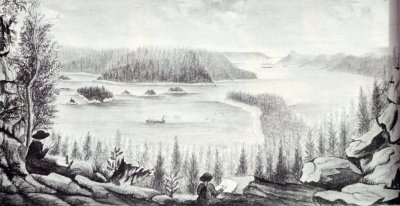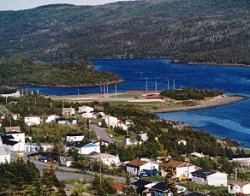Dunville


An incorporated community which lies along an 8 km long stretch of the North East Arm of Placentia Harbour, connected to Placentia Bay by a treacherous neck of water. North East Arm was the name of the settlement before it became Dunville. The harbour is good and well protected, however, it is shallow in places with protruding schoals and many islands which dot the middle of the arm. Early maps show the North East Arm heavily wooded and largely unpopulated; its high bluffs, steep shore, hills on the North side of the arm and is distance from the sea probably precluded settlement until the Eighteenth century.
The North East River runs into the Arm and is a major recreation area especially noted for salmon fishing. The North East Arm like the South East Arm was inhabited by the early fishermen. In 1751, Sir Admiral Francis W. Drake, Governor of Newfoundland, granted land to Martha Cottman which included the river - she had exclusive rights to 640 acres and the islands in the North East Arm. There were salmon and smokehouses on Salmon Island. This land is now owned by Hynes Construction and the United States Government. The Americans used their portion of this land as the North East Arm Recreation Camps when they occupied the Base at Argentia.
Hutchinson's Newfoundland Directory for 1864-1865 reported mainly boatkeepers and farmers in the North East Arm and listed family names of Barron, Blanch, Cain, Costello, Dumphy, Griffin, Hartigan, Kelly, Power, and Reilly. Some later names common to Dunville were Bishop, Byrde, Canning, Collins, Connors, Fennessey, Fitzpatrick, Flynn, Hartley, Hunt, Hynes, Kerrivan, Murphy, Murray, Patterson, Sparrow, Tobin, Viscount, Ward and Whiteway.
The first road connecting the North East Arm to Placentia was started in 1870 and later a lower road hugging the shoreline was built. In 1888 the branch railway, from Harbour Grace to Placentia via Dunville was built, providing new transportation and jobs for the area.
Dunville continued to be a thriving fishing centre until the 1920's, based mainly on the herring, cod, capelin, lobster and mackeral fisheries; the salmon fishery had fallen off in the late nineteenth century, probably from over fishing.
Gregory Power, a Minister in the Smallwood Government, was a native of Dunville and owned a large poultry farm in the 1940's. There were also two sawmills owned and operated by James Davis and the Dawe family. William and Leonard Hynes started a construction company in 1955 and at its peak in the 1980's employeed one hundred people. In 1941, construction of the Argentia Base bagan and brought year-round salaried jobs to the residents of Dunville. This new found increase in employment brought many new families with new religious denominations to the once almost exclusively Roman Catholic community and by the late 1950's to early 1960's an estimated ninety percent of the labor force in Dunville were employed in base-related jobs.
In the late 1960's the Electric Reduction Company of Canada (ERCO) phosphorous plant and the construction of a twenty-five unit housing development in Jordan's Cove meant more job opportunities for the residents of Dunville.
By 1969 an access road linking the community to the Trans Canada Highway was built.
In 1970 it was announced that a major reduction in the civilian work force at Argentia Base would eliminate nearly 300 jobs at the site. Although the opening of the ERCO plant in 1967 and some saw milling in the area were alternate sources of employment, Dunville was almost totally dependent on the base for employment. In 1979 the Dunville Mining Company was formed to provide silica for the ERCO plant. Operating from May to December, the quarry averaged about 100,000 toms of ore a year and employed fifteen to twenty people at peak. A small crafts company, Gannet Crafts, was established also in 1979 producing decorated items for sale in Canada and the United States; the company employed two people. A construction company was another source of work in 1981. In that year, however, it was announced the cutbacks in the ferry- transportation service from Argentia would result in a further loss of jobs.

In the census 1836 the North East Arm is included with settlements of Freshwater and Point Mal, but in 1845 it was reported in the census as an independent community of seventy-six inhabitants, all Roman Catholic.
In 1857 the census reports 232 inhabitants, including English and Irish born residents.
By 1884 the population in the North East Arm numbered nearly 400.
In the 1920's Dunville experienced a series of bad years in the fishery, and, with the Depression, the population was nearly halved, from 509 in 1911 to 261 in 1935.
Between 1945 and 1956 the population of Dunville increased from 287 to 869 and by 1966 it had reached 1622, this was due to the beginning of the American Base.
From 1966 to 1975 the population of Dunville once again increased from the influx of resettled families (255 people in forty-five households).
According to F.G. King(n.d) a school was operating in the North East Arm as early as 1850. In 1859 Bishop Mullock purchased land in the North East Arm and by 1860 a school house was built. According to a Roman Catholic School Inspector's Report for 1860, the North East Arm School was established in 1859 and was being finished at the time of the inspection in 1860, but in 1876 it was reported "The (Roman Catholic) school house at North East Arm was still unfinished and the windows had several panes of glass broke, and there were no desks. By 1914 the Dunville Superior School was in operation.
By 1952 an all grades Anglican School and United Church School had been built. In 1958 a new all grade Roman Catholic School was also built.
The first Roman Catholic church had been built in 1954, before this church services were held in the school house or attended in Placentia. The Anglican and United churches had been built in Dunville by 1965. The Baptist and Pentecoastal churches were built in 1970.
 By 1910 the Dunville Literary Society, aimed at "the moral and material advancement of its people
and the diffussion of knowledge among its members" had been formed. By 1970 the community
had a recrreation centre, and a town hall.
By 1910 the Dunville Literary Society, aimed at "the moral and material advancement of its people
and the diffussion of knowledge among its members" had been formed. By 1970 the community
had a recrreation centre, and a town hall.